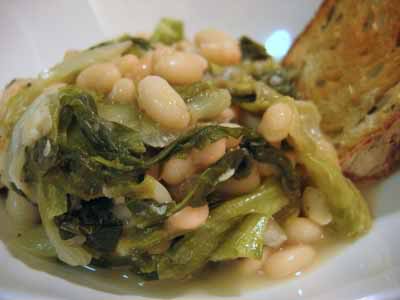
I’ve been unfaithful. Three times, just in the last two weeks. And I don’t feel a bit guilty.
For years, my list of favorite cookbooks has remained unchanged: The Barefoot Contessa Cookbook by Ina Garten, How to Cook Everything
by Mark Bittman, and The New Doubleday Cookbook
by Jean Anderson. When I needed information, instruction, or inspiration, they were my never-fail companions, my comfort, my pleasure. Their tattered and spattered pages were testament to my devotion.
And then my birthday rolled around, and I received a gift. A very seductive, very beautiful gift: All About Braising: The Art of Uncomplicated Cooking by Molly Stevens. Now, braising is hardly a sexy subject, but it’s just about the best way to cook at this time of year. As Stevens says in her introduction, “The Principles of Braising”:
“At its most basic, braising refers to tucking a few ingredients into a heavy pot with a bit of liquid, covering the pot tightly, and letting everything simmer peacefully until tender and intensely flavored….The miracle of braising lies in the fact that the process demands so little from the cook yet what actually occurs is quite complex and wonderful.”
That introductory chapter is, in my opinion, worth the price of admission all by itself. Covering such topics as “What really happens under the lid of a braising pot,” “Understanding why a certain cut of meat is tough or tender,” “Choosing the right braising pot,” “Alternative methods for browning,” and “Individualizing a braise,” it’s been like a mini-cooking course for me. I’ve made lots of braises in my time, but never with any particular thought or understanding of what I’m doing. That’s all different now. I’m openly, brazenly, deeply in love with braising, and with this fabulous cookbook.
My first date with my new paramour was Braised Celery with Crunchy Bread Crumb Topping:

Simple, elegant, subtle, it made me swoon. Convinced that this new relationship might have promise, I tried Braised Potatoes with Garlic & Bay Leaves (sorry, no pic). It, too, delivered pure, smooth, satisfying flavor with a wonderfully easy preparation. Could it be I was falling in love? One more tryst was all it took to convince me I’d found a new heartthrob: Escarole Braised with Cannellini Beans.
I’m a little embarrassed to admit this, but until I met All About Braising, I’d never made beans from scratch before—I’d always considered it too time-consuming, requiring too much advance planning. But something about Stevens’ encouraging, warm voice made me think that this time it might be worth it. I didn’t follow her bean-making instructions exactly—instead of soaking the beans for 8 to 12 hours, I boiled them for 2 minutes and let them soak for an hour or two—but I’m pretty sure the end result was just as lovely as it would’ve been done her way. The beans were creamy and tender, the escarole sweet and bitter at the same time, a sprinkle of red pepper flakes added spice, and a last-minute drizzle of fresh lemon juice and olive oil brought a level of bright, luscious flavor.
I haven’t even made it past the vegetable chapter yet. There’s still Chicken Breasts Braised with Hard Cider & Parsnips, Whole Chicken Braised with Pears & Rosemary, Pot-Roasted Brisket with Apples, and Red Wine-Braised Short Ribs with Rosemary & Porcini. These are the kinds of foods that make my heart race in the depths of winter—soothing, powerfully flavored, hearty yet not fat-drenched… I’m a goner, folks. Deeply in love with a cookbook. And I’m not ashamed to say it.
Escarole Braised with Cannellini Beans
Adapted from All About Braising: The Art of Uncomplicated Cooking
Serves 6, according to the book, but that’s as an appetizer or side. S and I ate the whole recipe for dinner, along with a salad and some toasted bread rubbed with garlic.
The Beans
1 cup (8 ounces) dried cannellini beans, picked over and rinsed [I couldn’t find cannellini, so I used Great Northern]
1 cup chicken stock
Water as needed
1 small onion (about 4 ounces), peeled and quartered
1 small carrot, peeled and quartered
2 garlic cloves, peeled and bruised
1 bay leaf
1 T. extra-virgin olive oil [optional]
Coarse salt
The Braise
1 medium head escarole (about 1 pound) [I used 2 small heads, about a pound and a half]
2 T. extra-virgin olive oil
3 garlic cloves, thinly sliced
Pinch of crushed red pepper flakes
Coarse salt & freshly ground black pepper
½ lemon
Best-quality extra-virgin olive oil for drizzling
Soaking the beans, according to the cookbook: Place the beans in a medium bowl, cover with water, and let soak for 8 to 12 hours at room temperature. Drain and rinse.
Soaking the beans, the quick way: Place the beans in a medium saucepan, cover with water, and bring to a boil over high heat. Let it boil for 2 minutes, then remove from heat and let soak for 1-2 hours. Drain and rinse.
Cooking the beans: Place the soaked beans in a medium heavy-based saucepan (2 ½- to 3-quart). Add the stock and enough water to cover by 1 ½ inches, then add the onion, carrot, garlic, bay leaf, and oil [I skipped the oil]. Bring to a simmer over medium heat. Once the liquid simmers, partially cover the pot, lower the heat to a gentle simmer, and cook until the beans are tender, 1 to 1 ½ hours. (The cooking time will vary according to the dryness of the beans.) If at any time the level of the liquid threatens to drop below the level of the beans, add just enough water to cover. Ideally, when the beans are tender, they should have absorbed enough of the cooking liquid so that the pot is moist but not soupy. [That didn’t exactly happen with mine—I may have put too much water in initially, but when the beans were tender it was still quite soupy. I just didn’t use all the liquid in the later step.] Season with salt to taste, and set aside to cool in the cooking liquid. (The beans may be made 1 to 2 days ahead. If they will be sitting for more than 2 hours, transfer the beans and the cooking liquid to a bowl and keep them covered and refrigerated.)
Washing and trimming the escarole: [Stevens’ method is fairly time-consuming and complicated. I didn’t follow it—I just cut my escarole into 1 ½-inch strips and dunked it in two changes of cold water, then pulled the floating leaves from the water and transferred to a colander.]
The aromatics: Combine the oil, garlic, and crushed red pepper in a large lidded skillet (12- to 13-inch) over medium heat. Warm just until the garlic becomes fragrant and golden around the edges, about 2 minutes. Don’t allow the garlic to become dark brown or you’ll have to start over.
Wilting the escarole: Add the escarole a handful at a time, stirring and allowing it to wilt some before adding the next handful. (It’s fine if the escarole still has water clinging to it, this will help it begin to braise.) Season with salt & pepper.
The braise: Pull the carrot and onion pieces and the bay leaf from the pot of beans and discard. But don’t be too fussy and try to get every last piece of onion, as some may have disintegrated right into the beans along with the garlic. When all the escarole has wilted, spoon the beans and cooking liquid into the skillet [remember, I had too much liquid so I didn’t use more than about ½ cup here], season with salt & pepper, gently stir to incorporate the beans. Bring to a gentle simmer. Cover, adjust the heat to maintain a low simmer, and braise until the greens are very tender and the cooking liquid has thickened some from the starch released by the beans, about 20 minutes.
The finish: Stevens prefers this dish soupy, so she serves it as is. If, like me, you’d like it less soupy, she says to remove the lid and boil to reduce the liquid for about five minutes. Season with a generous squeeze of lemon juice and salt & pepper. Serve warm or at room temperature, with a thread of best-quality olive oil drizzled over the top.
